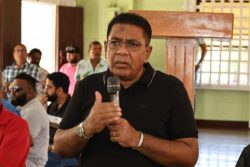This and previous articles are available at Chrisram.net
to which readers can post their comments
Introduction
Today’s column continues this series on the award of a US$15.4 million contract made by the government to Synergy Holdings Inc. for the construction of a road leading to the Amaila Falls, the site identified for the hydro-electricity project (AFHEP). Let us start with what we know: Mr Fip Motilall was given a licence by the President to develop the Amaila hydro project; the contract to construct the road to the project site flies in the face of common sense, economic logic and the Procurement Act; there are conflicting estimates of the cost and consequences to electricity consumers of the cost of power when the hydro-electricity facility comes into commercial operation. Beyond these basic pieces of information, there is a huge void. While the public pleads in vain with the government for details, columnists and letter writers seek to fill the void by undertaking extensive research to help the public understand what is being done in their name and for which they will bear the costs and receive the benefits.
The opposition PNCR a couple of weeks ago asked for the tabling of the Amaila Falls arrangements in the National Assembly. Nothing has been heard about that request but the leadership of that party was given a wonderful opportunity earlier this past week to pursue it when President Jagdeo invited them to meet him over local government elections. It was an opportune time to remind the President that under item 6 of the May 6, 2003 Communiqué he had committed to lay in the National Assembly “all existing and future agreements for GPL and the rest of the electricity sector.”
They could have gone further and reminded President Jagdeo that he had said to President Carter in August 2004 that “the government stands by all the commitments made in this agreement between him and PNC Chairman [sic] Corbin.”
Broken promises
Broken promises from President Jagdeo are nothing new but what is new and painful is that we are left with huge and frightening information gaps on critical aspects of what could be the largest project ever to be undertaken in the country. We cannot forget the President’s record on the largest to date – the Skeldon Factory in which he played the deciding role and which leaves the country in a big financial hole. The Skeldon project has so far been an embarrassing and costly burden – perhaps even bigger than critics had warned – and the demands on the taxpayers keep rising while budget targets made by the corporation’s dream team one year become useless the next.
As Skeldon has shown, the bigger and grander the project, the higher the risks and the greater the consequences of failure. Unfortunately caution is not a virtue associated with this government, and we seem to run blindly into disaster. The parallels between GuySuCo’s Skeldon Project and the Amaila project are frightening.
Conflicting numbers
There are essentially two projects involved with Amaila – the road and the hydro-electricity project itself. That the road project will cost taxpayers only the face value of the contract (US$15.4 million) cannot be assumed. The Request for Proposal said nothing about duty and tax concessions borne by the taxpayers but which could have made a huge difference to the bid price if one bidder was given exclusive assurance about tax concessions, disguised subsidies, or overruns.
The engineer’s estimate of the cost of the road project including bridges is in excess of US$20 million so we have to prepare ourselves for some major cost overruns. Dr Luncheon who was the first to defend the contract process now says that Synergy is behind the eight ball, which in billiards means in a losing position. If translated that means that Synergy cannot deliver on the contract, then the government will have no option but to throw more money into the road contract.
Dr Luncheon should have been more direct and tell us what the failure by Synergy to deliver the road project on time and on budget will mean, which is what the public needs to know. Instead it is another layer of confusion, coming just a couple of days ago after the government sought to contradict its own project manager/sponsor over the cost of the hydro project. In a letter to the local press Mr Rafael Herz, Sithe’s designated Project Manager said the estimated cost of the dam, powerhouse, transmission line and substations was US$650 million (including an estimated US$190 million for the transmission line and other supporting infrastructure). Two days later the government disputed the number, placing the figure at $495 million inclusive of the transmission line. And if we go back one year ago, the President had announced that “final studies” on the project would have been completed in August 2009 and that the bid for the project was US$600M. The final studies have clearly not been done, or costs determined.
Assuming there is a cost number, somewhere in this range, someone should say what it is. The difference between the two most recent numbers is 31% of what the government is now saying the figure should be. Hopefully, the press will seek an explanation from Mr Herz. Amid all the confusion then there is a project of at best uncertain cost. The reality is that there may be no actual number because there is as yet no contract for the construction of the hydro project itself. We know that Mr Motilall has the licence but whether that allows him to decide who will build the hydro-electricity project is not known, or what the guaranteed/ceiling price which GPL, the project’s customer will have to pay. The terms of the licence could help but that too is top secret.
The project licence
If anyone knows anything about the licence for the big deal that person is not letting on. Under the Hydro Electric Power Act (HEP), any licence has to be applied for to the Chief Works and Hydraulics Officer and is issued by the President. The application would contain critical technical and financial information evidencing vital capacity to fund, build and operate a hydro-electricity project. Since Synergy does not now possess those virtues, it was unlikely to have had them at the time the licence was issued to it in July 2002. It should therefore consider itself lucky that the President issued it with a licence in 2002 and then extended it first in October 2004, and then in 2006 for one year, even as its inadequacy became increasingly obvious. Section 7 of the HEP requires the payment of rent and royalties about which nothing has been heard, including whether Synergy has met such payment obligations. This is all very forgiving, considering the Financial Management and Accountability Act which requires special legislative authority.
A May 2006 MOU referred to in the third part of this series provided that the extended licence “shall be terminable by the government at any time during the one year extension” if Synergy failed to complete certain targets. The one year came and went, targets were set and missed, while Synergy committed to but never supplied a 25 MW thermal generating plant, because it never found the money to do so. Surely very few other than the President would entrust a 154 MW hydro-electricity project to a person who could not deliver a 25 MW of thermal power which can be bought on the internet.
But when it comes to Synergy all we have had from the government is grandstanding. In early 2008 the President threatened that if financial closure did not take place soon, the company would lose the “franchise” to build and operate the hydro facility. More than two years later, instead of terminating the licence and seeking a more reputable licensee, the government is now planning to put more taxpayers’ money into Synergy’s hands.
Scale of the project
Uncertainty also arises over the scale of the project and whether it is a single phase project or whether the 154 MW is just for starters. In August 2009 it was reported that Phase I would involve the installation of 154 MW capacity, Phase II 410MW and in Phase III, it would reach a further 1060 MW. If this is anywhere close to serious, we have to ask whether the Amaila Falls area has that volume of water, whether the second and third phases of the project go automatically to Synergy, who will buy this extra capacity, who will finance the later phases, and when does the BOOT kick in.
The Russians with their bauxite and the Brazilians have already indicated that they have their own ideas and ambitions about hydro-electric power in Guyana, which suggests that they are not interested in doing business with Synergy or Amaila. So the expansion may be a dream, a distraction or idle talk. Whichever it is, the public needs to know.
Start date
For starters, Synergy was under an obligation to begin construction of the hydro-electricity project in 2007 with commercial operation taking place in 2010. It failed miserably. The project manager-designate now says that construction will begin in early 2011 but with two caveats. The first is the completion of the road to enable the transportation of equipment and machinery and the second, obtaining debt financing. Now those are major caveats.
There is a lot of cynicism around and many even doubted that the AFHEP would get started. I think that with the single-mined obstinacy of the President and his adventurous way of committing state funds, the project will get going. But the President is returning from Oslo empty handed and with growing uncertainty about the timing of the inflow from Norway. The Budget already has a huge hole and his expressed impatience in Oslo when he realised the Norwegians and other donors were not sending him back with a bagful of money was his recognition of a potentially major setback. Maybe there is a link between human rights, extra-judicial killings and Amaila. On the positive side, the East Bank Demerara schoolchildren are spared the need to line the road for the President’s return which will be contrastingly low key.
Next week we look at cost, sources of funding and their implications for rates.





